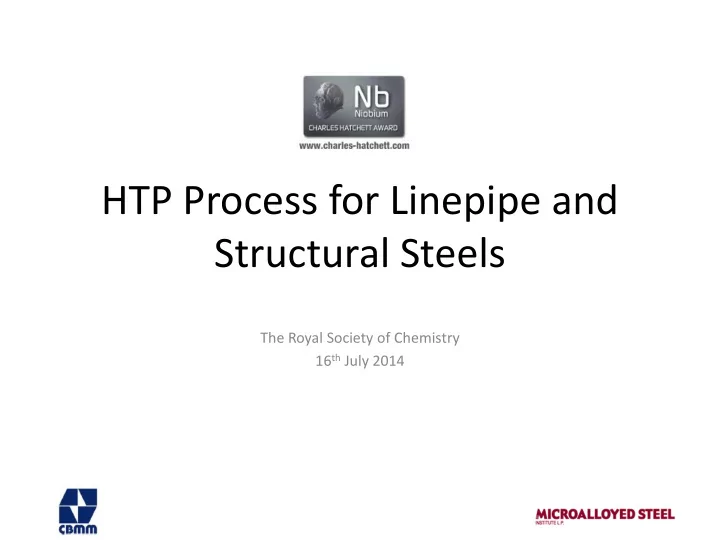

HTP Process for Linepipe and Structural Steels The Royal Society of Chemistry 16 th July 2014
Charles Hatchett Award • Creation 1977 • First Award 1979 14 out of 35 Medals involve Austenite Processing* * A major interest of CBMM since 1975
HTP Concept C 0.02 – 0.06 Percent Mn 1.50 – 1.85 Percent Nb 0.07 – 0.11 Percent (or Higher) Other Cr, Mo, Ni, Cu Produces high toughness plate obviating the need for powerful plate mills, controlled rolling and water cooling (accelerated cooling).
Application Precedes Understanding Concept Low carbon allows greater solubility of niobium – basis of J. M. Gray PhD Studies circa 1962-1965 (0.02%C 0.50%Mn 0.10%Nb) Proof of Concept BOFORS Heat 1971-1972 (0.06%C 1.60%Mn 0.10%Nb) First Applications Algoma Steel – TCPL 1974 (0.14%Nb) USINOR – Gazprom 1974 Hoesch – Czech Projects 1978
Fundamental Research DEFORMATION PROCESSING: RECOVERY, RECRYSTALLIZATION, PRECIPITATION & FERRITE FORMATION** M. J. Luton, R. Dorvel, R. A. Petkovic, Columbia University, New York, NY & J. M. Gray, Molycorp, White Plains, NY The results obtained in this way indicate that the presence of dissolved columbium causes a moderate reduction in the rate of static recovery, and a two fold decrease in the recrystallization rate. In the presence of finely dispersed columbium carbonitride precipitates, however, the rate of recrystallization is reduced by almost two orders of magnitude. **Presented at AIME Seminar on “Precipitation Processes in Structural Steels” Denver, Colorado, February 27 to 28, 1978.
Big Picture Sequential Contributions (Effects) of Niobium • Retards austenite grain growth during reheating. • Reduces austenite grain growth in the transfer bar. • Retards austenite recovery and recrystallization. during low temperature finishing (i.e. below T nr ). • Lowers austenite to ferrite transformation temperature. • Precipitation hardens ferrite.
Effect of niobium content on austenite grain size at a soaking temperature of 1175 ° C for three hours.
Retardation of recrystallization by microalloying elements.
Continuous cooling transformation diagram for a 0.02%C 0.49%Mn 0.10%Nb steel.
Influence of niobium in solid solution at the finish rolling temperature on the volume fraction of bainite in air cooled and accelerated cooled HTP plate.
Effect of niobium (columbium) content and finish rolling temperature on yield strength and notch toughness.
Progress of development showing simultaneous increase in toughness with strength and passage of time.
CVN Energy at -40C, J 400 300 200 100 Conv. Nb-V HTP 0 0 200 400 600 800 1000 Finish Cooling Temperature, C 550 Yield Strength, MPa 500 X-70 Min 450 400 Conv. Nb-V HTP 350 0 200 400 600 800 1000 Finish Cooling Temperature, C Wide processing window for yield strength of 0.03%C 1.6%Mn 0.095%Nb 0.27%Cr 22 mm plates cooled at 6°C/s
C Mn Nb V Cr Mo Grade Nb only 0.06 1.60 0.05 - - - X-65 Nb – V 0.09 1.60 0.04 0.08 - - X-70 Nb – Mo 0.04 1.70 0.09 - - 0.30 X-70/X-80 Nb – Cr 0.03 1.70 0.10 - 0.28 - X-70/X-80 Nb – Cr – Cu – Ni – Mo 0.03 1.60 0.05 - 0.28 0.30 X-80/X-100 Microalloying Systems used for Linepipe
Nb+Ti Elements wt, % C Mn Nb Ti Cr Mo Ni N CE Pcm +V CNPC Spec. max. 0.09 1.95 0.11 0.025 0.15 0.45 0.35 0.50 0.008 0.23 Coil Actual 0.05 1.74 0.10 0.018 0.12 0.28 Added 0.004 0.19 Plate Actual 0.05 1.92 0.10 0.012 0.12 0.24 0.10 0.24 0.006 0.18 Typical chemical composition of Chinese 18.4 mm X80 Hot Rolled Coil & Plate
2007 — X120 2005 — X100 2003 — X80 2000--X70 1998--X65 1993--X60 Rapid rate of adoption of API Grade X-80 linepipe in China.
PROGRESS IN ADOPTING X-80 STEEL
CONCLUSIONS • In 50 years we have moved from simple semi killed 0.24 percent carbon ingot cast steels to very sophisticated low carbon killed concast steels. • Fundamental metallurgy is much better known. • The rolling mill has become a sophisticated metallurgical tool. • X-80 has become the workhorse of high pressure onshore pipelines. • 65-70 percent is based on variants of the HTP concept on both old and new mills.
Recommend
More recommend